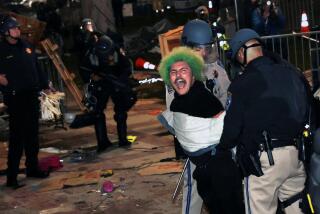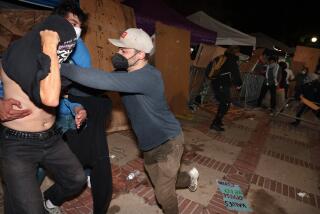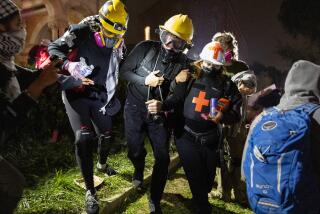COLUMN ONE : The Riots’ Enduring Wounds : The lingering bitterness of those injured in Los Angeles’ civil unrest stands in contrast to slogans about rebuilding and a return to ‘normal.’
In five days of rioting in Los Angeles, at least 1,850 people were shot, stabbed, burned, beaten or maimed--many of them left permanently disfigured or disabled by the trauma.
While some of their wounds have healed, what remain are mental and physical scars that bind them to one of the most wrenching chapters in Los Angeles history.
“There are nights I wake up sweating,” says Jose Ortiz, an 18-year-old Compton youth injured when an unknown gunman shot him in the back on the second day of the riots. “I hear that same bullet all the time.”
In their stories, the wounded offer a disturbing glimpse into the psyche of a broken city. Beneath a veneer of hope, their simmering bitterness challenges the slogans of rebuilding and the dreams that life will ever return to “normal.”
“Look at my body,” says “Jazzy,” a 24-year-old resident of the Nickerson Gardens housing project whose intestines now empty into a plastic sac on his side because a bullet pierced his back on the first night of the riots. “ ‘Just let it fade away,’ I say. But one day, I may go berserk.”
Three months ago, James Kang was a typical high school student in Glendale. Now, the 18-year-old Korean-American seems lost, bitter--still struggling to make sense of an attack that turned out to be a horrible mistake.
Kang’s hip was shattered by a rifle round that mangled his gut as it ricocheted in his body. A bullet in the neck killed his close friend, 18-year-old Edward Song Lee, in the same attack on a Koreatown sidewalk.
When police finally sorted out the shooting, they discovered that Kang and Lee had been shot by fellow Koreans who mistook them for looters in the confusion of the riots.
“I still can’t forgive for this,” Kang says, sinking into a couch in his family’s apartment. “It didn’t need to happen this way.”
Kang and Lee were shot on the second night of the riots, when looters and members of the Korean community battled for control of Koreatown.
As the rioting erupted, Kang at first was unconcerned about the mounting chaos he saw on television. But when the looting spread to Koreatown, he grew infuriated.
“They were breaking into stores like it was nothing, and the police were doing nothing about it,” he remembers. “What pissed me off was that they were enjoying themselves. It was like they were humiliating the Koreans. It was too much.”
As evening fell, he ran out of his house with a golf club in his hand. His mother chased him down the street, begging him not to go.
“Leave me alone,” he told her, driving off.
Kang was one of scores of Korean youths who answered calls put out on Korean-language radio for vigilantes to patrol the streets.
He was proud at first of volunteering. But as the night wore on, he began to have his doubts. The patrols saw plenty of looters, but they also discovered that many of the looting reports broadcast on the radio were phony.
“The store owners were home safe,” Kang recalls. “They just wanted to make sure their stores were safe.”
Fed up, Kang and his friends were ready to return to base camp when a new alarm went out: Looters on the rooftop of the Won San Myun Ok restaurant on 3rd Street. It was close, he thought. Why not drive by?
It was a fatal decision--one he has regretted every moment since.
As their two-vehicle caravan reached the restaurant, the driver in the lead car stopped suddenly and fired a shot into the air.
Lee, who was with Kang in the second car, stuck his head out the window. Almost immediately, he fell back into the car, shot in the neck by one of the Korean snipers positioned on the roof. Kang was hit, too, as dozens of bullets pierced the car.
He writhed in pain as the gunfire went on for what seemed like minutes, prepared to die. But the shooting unexpectedly stopped--because, Kang assumed, the attackers had run out of bullets.
Another friend in the car, 21-year-old Sam Lee, dragged Kang and Edward Lee onto the sidewalk before collapsing next to them, bleeding from shotgun wounds to his face and arm.
“Eddie was alive, he was breathing,” Kang remembers. They lay on the pavement for nearly half an hour before they were taken to the hospital, Kang says.
After three months, Kang still is tormented by the attack. He has undergone two operations and still limps. He has lost weight; in his old clothes, he looks skeletal.
As he recovers, Kang is spending much of his free time as a volunteer, helping distribute food to residents of Koreatown hard hit by the riots. He finds some solace in aiding his community.
But he has been unable to forget those few, brief minutes of shooting and the sight of his friend dying in front of him.
Kang still rails against the Koreans who opened fire from the rooftops without warning. He talks bitterly of the store owner who called in the false alarm of looting at the restaurants. He struggles to find some reason for his friend’s death.
“I have hatred for a lot of people now,” Kang said. “That’s all I have is hatred and anger.”
Finding some reason or meaning behind a traumatic experience is a critical part of the healing process, says Linda Boyd, assistant coordinator for disaster services at the Los Angeles County Department of Mental Health Services.
Even in natural disasters, such as earthquakes or floods, victims find comfort in understanding the scientific reasons for an event or seeing the occurrence as “God’s will.”
But for those wounded in the riots, Boyd says, the search for meaning and blame has been thwarted by the inexplicability of the attacks and the complexity of the motives behind the upheaval.
“We all need to view the world as meaningful and just,” she said. “When something like this happens, it just shoots that idea right out of the water.”
The search for answers is especially complicated for the wounded, who in almost every case do not know the identities of their attackers.
“This was a riot,” says Los Angeles Police Detective Art Daedelow, the lead investigator into the crimes committed at Florence and Normandie avenues. “We don’t even have all the victims. The fact is that there are a lot of these that we’re just never going to solve.”
There are some highly publicized exceptions, including the case of truck driver Reginald O. Denny, whose beating during the first hours of the riots was televised throughout the nation. Four men were arrested in connection with the crime less than two weeks after the riots, thanks in large part to videotape recorded by reporters.
And early this month, Los Angeles police arrested 22-year-old Thurman Woods in connection with the shooting of Firefighter Scott Miller, who was hit in the neck on the first night of the riots. Police Chief Willie L. Williams said a $37,500 reward helped bring forward informants who identified Woods.
But the vast majority of the wounded will never have that sense of resolution. And it has left many feeling defeated and uneasy.
“It’s like someone beat me and there’s nothing I can do about it,” said Jazzy, the Nickerson Gardens resident. “I’ll never forget. Healing the wound? They ain’t talking about me.”
Jazzy, a former gang member who did not want his full name used, believes he was shot by police officers who battled with armed rioters at the project on the first night of the riots. He has no way of discovering who shot him--and, in many ways, thinks he is better off not knowing. Police say the gun battle at Nickerson Gardens remains under investigation.
“You can’t win,” Jazzy says. “I want revenge on the one who shot me, but since I can’t find him, I got to let it go.”
The gunfight was one of the fiercest of the riots, ending with the deaths of two residents and the wounding of at least three others.
The shooting began after a group of about 30 LAPD Metro Division officers arrived at the project about 11 p.m. to cover Fire Department units fighting a blaze nearby. Police and armed rioters in the area exchanged fire for several hours.
Jazzy insists that he had been working all day with his father, a truck driver, and was heading home from a friend’s apartment when the shooting began.
He was stunned as he watched the crowd running wildly around him and the groups of officers and rioters firing at each other.
He did not feel the bullets that hit him--just a sensation that his legs were growing weak. In a moment, they gave way and he tumbled onto the pavement. He could hear the sound of bullets landing around him and other people screaming, “I’m hit! I’m hit!”
For 20 minutes, he lay on the ground, unable to move. Amid the shooting, no one was able to pull him to safety.
Two bullets had torn into his stomach and intestines. He spent a week in the hospital, leaving with a foot-long scar on his stomach and the plastic pouch at his waist.
Like others who were seriously wounded in the riots, Jazzy says his close brush with death has refocused his life and made him appreciate simple things that he once took for granted.
“Gang-banging, that’s all I used to do,” says the wispy young man, sitting on a stoop in the project. “Now I think about good stuff. I’ve been through bad stuff all my life.”
He talks of forgiveness and putting the incident behind him. “Hey, things happen,” he says. “I don’t get mad about nothing.”
But whatever peace he has found can disappear in a second when he thinks about whoever it was that shot him. He once dreamed of revenge--of “taking an AK to every policeman and blast them,” referring to an AK-47 assault rifle.
Now, he pushes those thoughts down deep--although never deep enough.
“Every time I jump in the shower, there’s a scar I got to look at,” the young man says. “Every time I look at myself like this I’m angry.”
Of the 1,850 people injured in the riots, the vast majority were quickly treated and released; just 280 were admitted to hospitals with serious injuries--the majority for gunshot wounds.
Of all the wounded, only one is still hospitalized--Wallace Tope, a Pasadena evangelist beaten when he tried to stop looters from pillaging a Sav-On drugstore in Hollywood. He still lies in a coma in a nursing home.
The others, mostly released within a few days, have little more than surface scars left from the experience. But even those whose injuries have healed say they have lost a sense of safety and well-being that is sometimes more painful to bear.
Jose Ortiz, shot on a Compton street by a man he had never seen before, says he no longer feels comfortable doing things he once took for granted, such as walking the streets around his home.
After his release from the hospital, some friends took him out for a night of celebration. But he cut the evening short and asked to be taken home.
“I’m paranoid a lot,” Ortiz explains.
He once had plans to work overseas as a welder. But because his injuries have left him weakened and in constant pain, he has been advised by his doctor to look for an office job.
“I once was able to do what I wanted. I had plans,” Ortiz said. “Don’t think you’re untouchable. One of these days, somebody will come around and get you.”
Elvira Evers, nine months pregnant when she was shot in the abdomen by gang members, says that in many ways, the shooting was the easy part.
Evers, a cafeteria cashier, was walking back to her apartment in Compton during the riots when a neighbor noticed blood on her dress. She didn’t even know she had been shot.
At the hospital, stunned doctors delivered her baby, pulling a bullet from the infant’s right elbow. Her daughter, Jessica, has only a tiny scar left.
Through the ordeal, Evers says she was calm and unafraid for herself. She was ready to drive to the hospital on her own until a neighbor stopped her. She walked into the emergency room herself, bleeding from her belly.
But since returning home, she has rarely ventured outside; even inside she still worries about being shot again. In the daytime, she is too tense to eat; she has her one meal of the day in the evening, when the streets have calmed down.
She prays about leaving the neighborhood.
“I’m grateful for being alive, but no one knows what I’m going through,” the new mother, 39, says. “Every day, I want to leave this place.”
Victims of the Riot
Here is a look at the number of people injured during the first five days of the Los Angeles riots, according to a preliminary estimate by the Hospital Council of Southern California.
Treated in Emergency Rooms
Beatings: 269
Gunshot wounds: 198
Stabbings: 57
Burns: 17
Miscellaneous*: 1,309
Total victims treated: 1,850
*Includes injuries that hospitals did not categorize.
Admitted to Hospitals
Beatings: 26
Gunshot wounds: 63
Stabbings: 17
Burns: 5
Miscellaneous*: 169
Total victims admitted: 280
Total deaths**: 51
**The county coroner’s official figure is 51 and may be increased to 52 to include a body discovered Aug. 12. However, a Los Angeles Times survey of law enforcement investigators throughout the county puts the total at 45.
More to Read
Sign up for Essential California
The most important California stories and recommendations in your inbox every morning.
You may occasionally receive promotional content from the Los Angeles Times.











